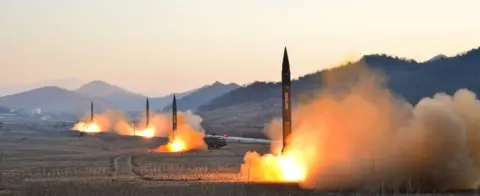North Korea crisis in 300 words
 Reuters
ReutersDespite two summits in 2018 and 2019, and then a historic meeting at the Korean border, the future of the US-North Korea talks look bleak.
Here's an overview of a saga that has at times threatened nuclear war.
Why did North Korea develop nuclear weapons?
The Korean peninsula was divided after World War Two and the North developed an authoritarian form of government.
Isolated globally, it saw nuclear weapons as a deterrent against a world it believed was seeking to destroy it.
Could it carry out a nuclear attack?
Probably. Pyongyang has carried out six nuclear tests.
It claims, though this remains unverified, to have developed a nuclear bomb small enough for a long-range missile.
It also has a ballistic missile experts believe could reach the US, and in 2019 tested a missile that could carry a nuclear weapon and be launched from a submarine.
At the start of 2020, Kim Jong-un ended the country's moratorium on nuclear testing.
How did talks begin?
After months of escalating mutual threats, in January 2018 Mr Kim said he was "open to dialogue".
Mr Trump accepted, ignoring past pre-talk conditions that North Korea denuclearise first.
The two signed an agreement committing to the "complete denuclearisation of the Korean peninsula" but with no detail on what that meant.
Back to stalemate?
Since then, there has been little progress, despite more talks.
The US wants North Korea to unilaterally give up its nuclear weapons while Pyongyang wants a step-by-step approach to ease the crippling sanctions regime.
The most recent talks between officials, though not leaders, took place in Sweden in October 2019.
The US said "good discussions were had" but North Korea said the US "brought nothing to the negotiation table".
Since then, North Korea has continued missile testing., while the US has urged Pyongyang to resume talks.
Want to know more?
- North Korea's missile and nuclear programme
- N Korea hails test as South condemns virus timing
- Trump's birthday wishes to Kim 'not enough'
- North Korea ends moratorium on nuclear testing
- Kim Jong-un calls for 'offensive' security policy
- The tiny South Korean island watching the horizon
- North Korea attacks Trump's 'dotage of a dotard'
- N Korea threatens Japan with 'real missile'
- North Korea 'willing to restart' US nuclear talks